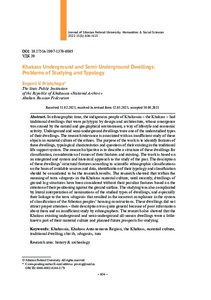Khakass Underground and Semi-Underground Dwellings: Problems of Studying and Typology
Скачать файл:
URI (для ссылок/цитирований):
https://elib.sfu-kras.ru/handle/2311/143758Автор:
Prishchepa, Evgenii V.
Прищепа, Е. В.
Дата:
2021Журнал:
Журнал Сибирского федерального университета. Гуманитарные науки. Journal of Siberian Federal University. Humanities & Social Sciences; 2022 15 (5)Аннотация:
In ethnographic time, the indigenous people of Khakassia – the Khakass – had traditional dwellings that were polytypic by design and architecture, whose emergence was caused by the natural and geographical environment, a way of lifestyle and economic activity. Underground and semi-underground dwellings were one of the understudied types of their dwellings. The research relevance is associated with an insufficient study of these objects in material culture of the ethnos. The purpose of the work is to identify features of these dwellings, typological characteristics and questions of their existing in the traditional life support system. The research objective is to describe a structure of these dwellings for classification, consideration of issues of their features and existing. The work is based on an integrated and system and historical approach to the study of the past. The description of these dwellings’ structural features according to scientific ethnographic classifications on the basis of available sources and data, identification of their typology and classification should be considered to be the research results. The research showed that within the meaning of term «dugout» in the Khakass material culture, until recently, dwellings of ground log structures have been considered without their peculiar features based on the criterion of their positioning against the ground surface. The studying was also complicated by literal interpretation of nominations of the studied types of dwellings, and especially their linkage to the term «dugout» that resulted in the incorrect compliance in the system of classification of the Siberian peoples’ housing constructions. These dwellings did not attract proper attention – their description was quite general because of poor information about them and an insufficient study by ethnographers. The research also showed that the Khakass existing underground and semi-underground all-season dwellings were a little-known part of their material culture and planned future prospects for studying В этнографическое время у коренного населения Хакасии – хакасов
существовали разнотипные по конструкции и архитектуре традиционные жилища,
появление которых было обусловлено природно-географической
средой, характером
образа жизни и экономической деятельностью. Одним из малоисследованных типов
их жилищ были подземные и полуподземные жилища. Актуальность исследования
обусловлена недостаточной изученностью данных объектов в материальной
культуре этноса. Цель работы – выявление особенностей данных жилищ,
типологических характеристик и вопросов их бытования в системе традиционного
жизнеобеспечения. Задачи исследования – описание конструкции данных жилищ для
целей классификации, рассмотрение вопросов их особенностей и бытования. Работа
основана на комплексном и системно-историческом
подходе к изучению прошлого.
Результатами исследования следует считать описание конструктивных особенностей
данных жилищ, в соответствии с научными этнографическими классификациями
на основе доступных источников и данных, выявление их типологии и классификация.
Исследование показало, что в рамках значения термина «землянка» в материальной
культуре хакасов до последнего времени рассматривались жилища наземных
срубных конструкций без их специфических черт, основывающихся на критерии
их расположения по отношению к поверхности земли. Затрудняло задачу изучение
и дословная интерпретация номинаций изучаемых типов жилищ, а особенно их
привязка к термину «землянка», что привело к неверному соответствию в системе
классификации жилищных построек народов Сибири. Эти жилища не привлекали
к себе должного внимания, их описание было весьма общим из-за
ограниченности
сведений о них и недостаточной изученности этнографами. Исследование также
показало, что бытовавшие подземные и полуподземные всесезонные жилища хакасов
являлись малоизвестной частью их материальной культуры, и наметило будущие
перспективы изучения
Коллекции:
Метаданные:
Показать полную информациюСвязанные материалы
Показаны похожие ресурсы по названию, автору или тематике.
-
Историографический обзор научной литературы конца XIX - первого десятилетия XXI вв. по проблеме этнической идентификации хакасского этноса
Неволько, Н.Н.; Nevolko, Natalya N. (Сибирский федеральный университет. Siberian Federal University., 2011-06)The article is devoted to the historiographic review of the Russian scientific literature concerning the problem of the Khakass ethnos identification. The main attention is paid to the literature of the end of the XIX to ... -
Визуализация этнической темы в живописных и графических произведениях искусства хакасских мастеров
Неволько, Н.Н.; Nevolko, Natalia N. (Сибирский федеральный университет. Siberian Federal University., 2011-08)The article is devoted to the specific visualization of ethnic culture in the works of Khakass graphic artists and painters. Researching the tendency of artists appealing to the ethnic theme, the author covers the entire ... -
The National Visual Art in the Process of Formation and Preservation of the Ethnic Identity of Indigenous Peoples (by the Example of Khakass Visual Art)
Koptseva, Natalia P.; Nevolko, Natalia N.; Копцева, Н.П.; Неволько, Н.Н. (Сибирский федеральный университет. Siberian Federal University., 2012-08)The article is devoted to the various research positions with respect to the understanding of the culture system. The place of culture of the ethnic groups in the modern pluralistic society is determined. The authors ... -
The Iconographic Tradition of Prienisei Siberia: Notes on the History of Formation and Regional Specifics
Asochakova, Valentina N.; Chistanova, Svetlana S.; Асочакова, В. Н.; Чистанова, С. С. (Journal of Siberian Federal University. Сибирский федеральный университет, 2023-12)This article examines an element of the religious landscape of Prienisei Siberia in the 18th and 19th centuries as the decoration of Orthodox churches. During this period, the Russian Orthodox population was more than ... -
The Russian Orthodox Church in the Khakass-Minusinsk Region under the Circumstances of its Settling (the 18 c. – the 1860s)
Asochakova, Valentina N.; В.Н. Асочакова (Сибирский федеральный университет. Siberian Federal University, 2008-12)In the article there is a problem of the ethno-demographical conditions in the Khakass-Minusinsk region that influence the functioning of the Russian Orthodox Church. The use of the sources of the church demographical ...

